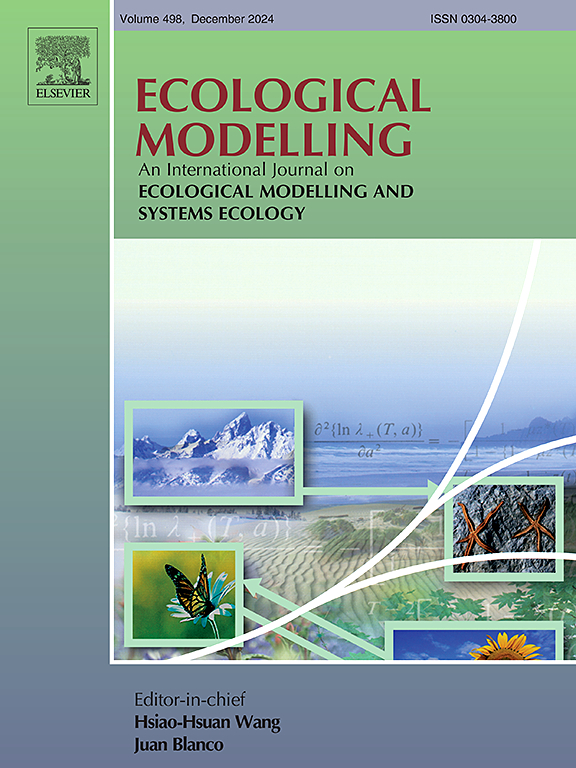利用一种新的生物经济林业模型优化中欧山毛榉森林木材收获和生物多样性保护价值的利润
IF 3.2
3区 环境科学与生态学
Q2 ECOLOGY
引用次数: 0
摘要
我们如何在保持不同森林生态系统功能的同时实现木材采伐的经济目标?解决这类问题的现有森林模型通常是复杂的、数据密集的,很难与经济优化模型相结合,或者不容易推广到年龄不均匀的混合物种森林。在这里,我们开发了一个生态经济优化模型,将生态现实主义与数学可追溯性相结合,从而具有数字优化的能力。这种方法使库存校准森林模拟模型成为可用于快速经济分析的最佳和最广泛测试的模型之一。作为概念验证,我们将该模型应用于德国图林根州hainich - d本文章由计算机程序翻译,如有差异,请以英文原文为准。
Optimising profits from timber harvest and the biodiversity conservation value in a central European beech forest using a novel bioeconomic forestry model
How can we meet economic objectives of timber harvesting while maintaining the functioning of diverse forest ecosystems? Existing forest models that address this type of question are often complex, data-intensive, challenging to couple with economic optimisation models, or can not easily be generalised for uneven-aged mixed-species forests. Here, we develop an ecological-economic optimisation model that combines ecological realism with mathematical tractability and, thus, the ability to be optimised numerically. This approach makes one of the best and most widely tested inventory-calibrated forest simulation models available for rapid economic analyses. As a proof-of-concept, we apply the model to a beech-dominated forest in the Hainich-Dün region in Thuringia, Germany. The ecological module is the Perfect Plasticity Approximation (PPA) demographic forest model that simulates forest dynamics based on individual tree growth and survival rates in the canopy and understory layers, respectively, as well as recruitment rates. We used repeated forest inventory data from a 28-ha forest plot to quantify these demographic rates and validated the predictions of the ecological module against the structure of old-growth beech forests in Europe. The economic module includes the optimization of the present value of net revenues (market revenues net of harvesting cost) from harvesting timber. We use Pareto fronts to quantify the trade-off between the economic and the biodiversity conservation value of the forest. As an indicator of the biodiversity conservation value of the forest, we use the number of retained potential habitat trees (>70 cm diameter). The forest model delivered reasonable predictions of structural attributes of unmanaged old-growth beech forests. When net revenues from timber harvesting were maximised, trees were logged when they reached 60 cm (no discounting) or 40 cm (discounting with 1.5 % interest rate) in diameter. This is similar to current management practices in beech forests. We found an approximately linear trade-off between steady-state timber net revenues and the number of retained habitat trees and that compensation programs currently implemented in Germany cover considerably higher costs for the retention of 10 habitat trees per hectare (240 Euros/ha/y) than we observe (no discounting: 109 Euros/ha/y; discounting: 89 Euros/ha/y in lost steady-state net revenues). We established a generic ecological-economic modelling framework that reliably represents forest dynamics and identifies optimal harvesting regimes over the full set of feasible strategies. The framework can easily be extended to different forest types, to mixed-species forests, and to the optimisation of multiple ecosystem services.
求助全文
通过发布文献求助,成功后即可免费获取论文全文。
去求助
来源期刊

Ecological Modelling
环境科学-生态学
CiteScore
5.60
自引率
6.50%
发文量
259
审稿时长
69 days
期刊介绍:
The journal is concerned with the use of mathematical models and systems analysis for the description of ecological processes and for the sustainable management of resources. Human activity and well-being are dependent on and integrated with the functioning of ecosystems and the services they provide. We aim to understand these basic ecosystem functions using mathematical and conceptual modelling, systems analysis, thermodynamics, computer simulations, and ecological theory. This leads to a preference for process-based models embedded in theory with explicit causative agents as opposed to strictly statistical or correlative descriptions. These modelling methods can be applied to a wide spectrum of issues ranging from basic ecology to human ecology to socio-ecological systems. The journal welcomes research articles, short communications, review articles, letters to the editor, book reviews, and other communications. The journal also supports the activities of the [International Society of Ecological Modelling (ISEM)](http://www.isemna.org/).
 求助内容:
求助内容: 应助结果提醒方式:
应助结果提醒方式:


